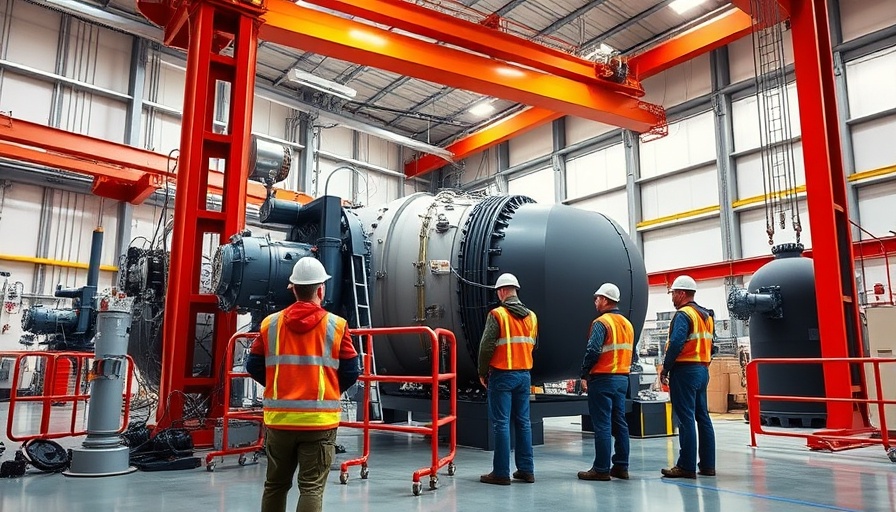
The Fusion Frontier: A Leap Towards Sustainable Energy
Commonwealth Fusion Systems (CFS) has recently achieved a significant milestone in the pursuit of sustainable energy through nuclear fusion. The installation of a 24-foot wide cryostat base marks not only a critical development for its Sparc demonstration reactor but also a hopeful step toward harnessing the power of the stars right here on Earth.
The cryostat base, weighing 75 tons and specially crafted in Italy, represents the foundational piece needed to support the tokamak—the reactor's core. As Alex Creely, director of tokamak operations at CFS, stated, “It is the first piece of the actual fusion machine.” This completion comes after over three years of construction, signaling a transition from merely assembling an industrial facility to actively building the heart of a fusion reactor.
A New Era for Nuclear Energy
CFS stands out in a wave of startups exploring fusion technology. The hope is that fusion will provide a nearly inexhaustible source of pollution-free electricity derived from hydrogen isotopes found in seawater. As global demand for energy surges—with electric vehicles and expansive data centers now commonplace—the potential of fusion power looks brighter than ever.
Bill Gates's Breakthrough Energy Ventures has provided backing to CFS, showcasing the confidence investors have in its potential to prove fusion commercially viable. CFS plans to place its first commercial-scale reactor outside Richmond, Virginia, with the Sparc reactor aiming to come online as early as 2027. If successful, the Sparc reactor could be the first tokamak to produce more energy than it consumes, an achievement that could revolutionize the energy landscape.
Understanding the Science Behind Fusion
Fusion power relies on creating conditions where hydrogen nuclei can combine to form helium, releasing substantial energy. Unlike conventional nuclear energy that fissions atomic nuclei, fusion promises a safer, cleaner alternative. Only the U.S. Department of Energy's National Ignition Facility (NIF) has recently succeeded in scientific break-even, where the energy output equals the input, using laser technology. In contrast, CFS employs superconducting magnets to contain superheated plasma at extreme temperatures of nearly 100 million degrees Celsius, compressing it until fusion occurs.
This innovative approach necessitates cooling the superconducting magnets to -253 degrees Celsius, a task aided by the newly installed cryostat base which acts as a thermos, ensuring the necessary frigid environment is maintained. As outlined by Creely, “The cryostat base is basically like the bottom of the thermos.” This advancement is crucial for achieving the stable plasma needed for sustainable fusion reactions.
The Importance of This Development in Today's Context
The achievement of CFS is particularly significant given our current global energy challenges. Climate change and environmental degradation demand urgent action and transformative energy solutions. With increasing reliance on renewable energy sources, breakthroughs in fusion technology could play a pivotal role in meeting climate targets. CFS is viewed as one of the best prospects for proving whether fusion power can be integrated into the existing energy matrix.
As we see fossil fuels contributing to alarming pollution levels, and renewable sources grapple with intermittency issues, fusion technology represents a beacon of hope that could provide a steady energy flow with minimal carbon footprint.
What Lies Ahead: Future Predictions for Fusion Technology
As the world leans toward greener solutions, the significance of fusion energy cannot be underestimated. If successful, CFS’s Sparc project could be a game-changer in energy generation, drastically reducing dependency on fossil fuels and transitioning toward a sustainable energy future.
Looking forward, we can anticipate an increase in funding and research dedicated to fusion technology as governments and investors recognize its potential. With a strong focus on innovation, CFS and similar firms are not just racing against time but are also setting the stage for future technological advancements in energy generation.
Join the Conversation on Innovative Energy Solutions
As CFS moves forward with its ambitious project, it ensures that discussions about nuclear fusion are not confined to scientific circles but engage the broader public. Keeping abreast of developments in this promising field could inspire policymakers and investors across the globe. Understanding fusion technology’s role in our energy future is crucial for informed debates about climate change and energy policy.
The future of energy may very well depend on how effectively we can harness the power of fusion. So stay tuned for more updates from the cutting-edge frontier of energy development!
 Add Row
Add Row  Add
Add 



Write A Comment